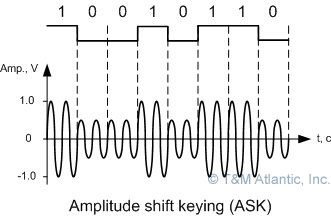| www.tmatlantic.com
Test & Soldering Equipment On-line Store |
|
D.E.V.I.C.E. (Wiki)Calculators Services |
|||||
Filter by first letter
|
KeyingKeying is the transition process of one or several high-frequency signal (which is called carrier) parameters under the law of low-frequency discrete data message. In the telecommunication field information is usually digitized, i.e. it’s represented as successive integral numbers which are called symbols. To transfer digital information there is transformation needed which means each digital code symbol matches its own carrying oscillation parameter – amplitude, frequency or phase. In the transformed signal each new symbol leads to the discontinuous variation of carrier signal parameter. Such shift keying type when the carrying oscillation parameters change abruptly is called keying. The main keying types are: amplitude shift keying (ASK), frequency shift keying (FSK) and phase shift keying (PSK). In the picture below there is an example of amplitude shift keying of sinusoidal carrier signal.
|
Site mapPrivacy policyTerms of Use & Store PoliciesHow to BuyShippingPayment




|


























